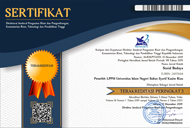Arat Sabulungan as A Sacred Ecology: Sustainable Consumption and Climate Change Adaptation Among the Mentawai Tribe
Abstract
Climate change and consumption of sustainable resources are global issues internalized in the Sustainable Development Goals (SDGs). In fact, local wisdom has accommodated the concept of sustainable development. However, local wisdom is currently less involved in the SDGs. This research seeks to ensure that local wisdom, including the Mentawai Arat Sabulungan (AS), can support SDGs 12 and 13 in Indonesia. The purpose of this research is to explore the position and role of the AS, to analyze the correlation between the AS and the SDGs mission to address climate change and sustainable resource consumption, and to formulate efforts to implement national SDGs points 12 and 13 through a cultural approach. The research method used is qualitative research by collecting data through interviews, observation, and literature studies. The results of this study are: First, AS is the belief system of the Mentawai people as an ecological awareness that is based on sacred values and functions as a religious principle, social norm, and environmental conservation. Second, the AS concept of sacred ecology has relevance to the SDGs on sustainable consumption and efforts to deal with climate change. Third, the strategy for implementing SDGs points 12 and 13 can be carried out by localizing it.
Keywords
Full Text:
PDFReferences
Afandi, T. (2017). Siaran Pers Seminar Kebudayaan Indonesia: Peran Kebudayaan Dalam Pembangunan Nasional. Http://Www.Ksi-Indonesia.Org/.
Ahmad, Y., & Lutfi, P. (2020). Tinjauan konsep keberlanjutan pada kawasan permukiman Summarecon Bekasi dalam aspek sosial. Jurnal Arsitektur PURWARUPA, 4(2), 23–30.
Arman, J., Afrizal, & Asrinaldi. (2018). NEGARA DAN MASYARAKAT ADAT (Studi Pemanfaatan Kawasan Hutan Oleh Masyarakat Adat di Desa Matotonan Kecamatan Siberut Selatan Kabupaten Kepulauan Mentawai). JISPO, 8(2), 88–116.
Badan Pusat Statistik. (2016). Potret awal tujuan pembangunan berkelanjutan (Sustainable Development Goals) di Indonesia. In Katalog BPS. Badan Pusat Statistik.
https://filantropi.or.id/pubs/uploads/files/3 BPS Potret Awal TPB di Indonesia.pdf
Berkes, Fikret. (2012). Sacred Ecology (T. Edition (ed.)). Routledge. https://doi.org/10.5840/enviroethics20002247
Berkes, Firket, Colding, J., & Folke, C. (2000). Rediscovery of Traditional Ecological Knowledge as Adaptive Management. Ecological Applications, 10(5), 1251–1262.
Coronese, S. (1986). Kebudayaan Suku Mentawai. Penerbit Grafidian Jaya Jakarta.
Delfi, M. (2012). Sipuisilam Dalam Selimut Arat Sabulungan Penganut Islam Mentawai Di Siberut. Al-Ulum, 12(1), 1–34.
Delfi, M. (2013). Contemporary Mentawai recapitulates ancestry: the position of women in Siberut society. Jurnal Humaniora, 25(1), 14–24.
Delfi, M. (2014). Islam and Arat Sabulungan in Mentawai. Al-Jami’ah, 51(2), 475–499. https://doi.org/10.14421/ajis.2013.512.475-499
Global Footprint Network. (2022). Global Footprint Network Data. https://data.footprintnetwork.org/#/
Glossanto, K. (2019). Sabulungan Dalam Tegangan Identitas Budaya : Kajian atas Religi Orang Mentawai di Siberut Selatan. 92.
Hammons, C. S. (2016). Indigenous Religion, Christianity and the State: Mobility and Nomadic Metaphysics in Siberut, Western Indonesia. Asia Pacific Journal of Anthropology, 17(5), 399–418. https://doi.org/10.1080/14442213.2016.1208676
Leal Filho, W., Nzengya, D., Muasya, G., Chemuliti, J., & Kalungu, J. W. (2017). Climate change responses among the Maasai Community in Kenya. Climatic Change, 145(1–2), 71–83. https://doi.org/10.1007/s10584-017-2087-9
Mago, P., Bhatiya, R., Gosain, N., & Awasthi, D. (2022). Bishnoi community model: an Indian Ecological Feminist approach to environment protection. Ecofeminism and Climate Change, 3(1), 56–67. https://doi.org/10.1108/efcc-06-2021-0011
Marfai, M. A. (2022). Pengantar Etika Lingkungan dan Kearifan Lokal. Gadjah Mada University Press.
Mulhadi. (2008). Kepercayaan Tradisional “Arat Sabulungan” dan Penghapusannya di Mentawai. Jurnal Equality, 13(1), 50–65.
Osman, I. E., Rahmanita, M., Brahmantyo, H., Wibowo, D., & Sulistiyo, T. D. (2021). Sikerei Lifestyle in Cultural Preservation for Sustainable Tourism in Mentawai Island, Indonesia. Journal of Hunan University (Natural Sciences), 48(5), 47–57.
Pretty, J. (2004). How nature contributes to mental and physical health. Spirituality and Health International, 5(2), 68–78. https://doi.org/10.1002/shi.220
Ramadhani, R., Hasanuddin, W. S., & Juita, N. (2017). Struktur Cerita Rakyat Legenda Si Bajak Si Kelak Kulit dan Fungsi Sosialnya pada Masyarakat Desa Simalegi Kecamatan Siberut Barat Kabupaten Kepulauan Mentawai. Jurnal Bahasa Dan Sastra, 5(1), 1–10. http://ejournal.unp.ac.id/index.php/ibs/article/view/9874
Roth, D., & Sedana, G. (2015). Reframing Tri Hita Karana: From ‘Balinese Culture’ to Politics. Asia Pacific Journal of Anthropology, 16(2), 157–175. https://doi.org/10.1080/14442213.2014.994674
Sartini, & Ahimsa-Putra, H. S. (2017). Preliminary Study on Worldviews. Jurnal Humaniora, 29(3), 265–277. https://doi.org/10.22146/jh.29690
Schefold, R. (1988). Lia: das grosse Ritual auf den Mentawai-Inseln (Indonesien). Dietrich Reimer Verlag.
Senatung, M. (2005). Kearifan Lokal Masyarakat Mentawai dalam Pengelolaan Sumber Daya Hutan dan Lingkungan di Pulau Siberut Propinsi Sumatera Barat. Universitas Gadjah Mada.
Sharifian, A., Fernández-Llamazares, Á., Wario, H. T., Molnár, Z., & Cabeza, M. (2022). Dynamics of pastoral traditional ecological knowledge: a global state-of-the-art review. Ecology and Society, 27(1), 1–63. https://doi.org/10.5751/ES-12918-270114
Simatupang, D. E. (2017). Kearifan Lokal Dahilan Natolu Sebagai Bingkai Tiga Pilar Pembangunan Berkelanjutan Kawasan Danau Toba. Jurnal Kebudayaan, 12(2), 95–96. https://jurnalpuslitjakdikbud.kemdikbud.go.id
Susilo, R. K. D. (2008). Sosiologi Lingkungan. RajaGrafindo Persada.
Tulius, J. (2020). Lesson From the Past, Knowledge for the Future: Roles of Human Memories in Earthquake and Tsunami Narratives in Mentawai, Indonesia. Paradigma: Jurnal Kajian Budaya, 10(2), 147. https://doi.org/10.17510/paradigma.v10i2.396
Tulius, J., & Burman-Hall, L. (2022). Primates and Birds of Sabulungan: Roles of Animals in Sculptures, Shamanic Songs and Dances, and the Belief System of Traditional Mentawaians. Wacana, 23(2), 451–490. https://doi.org/10.17510/wacana.v23i2.1090.452
United Nations. (2019). Culture and Sustainable Development. https://www.un.org/pga/73/event/culture-and-sustainable-development/
World Meteorological Organization. (2022). State of the Global Climate 2021. https://library.wmo.int/index.php?lvl=notice_display&id=21880#.YHg0ABMzZR0
Yolanda, F., & Willis, R. (2018). Kearifan Lokal Arat Sabulungan dalam Pengelolaan Hutan ( Studi Kasus Hutan Adat Suku Saerajen dan Suku Samongilailai di Desa Malacan Kecamatan Siberut Utara). Jurnal Buana, 2(3), 794. https://doi.org/10.24036/student.v2i3.136
Zheng, X., Wang, R., Hoekstra, A. Y., Krol, M. S., Zhang, Y., Guo, K., Sanwal, M., Sun, Z., Zhu, J., Zhang, J., Lounsbury, A., Pan, X., Guan, D., Hertwich, E. G., & Wang, C. (2021). Consideration of culture is vital if we are to achieve the Sustainable Development Goals. One Earth, 4(2), 307–319. https://doi.org/10.1016/j.oneear.2021.01.012
DOI: http://dx.doi.org/10.24014/sb.v20i1.22248
Refbacks
- There are currently no refbacks.
Published by:
Center for Research and Community Development
Universitas Islam Negeri Sultan Syarif Kasim Riau
Jl. H. R. Soebrantas KM 15,5 ,Tuah Madani, Tampan,
Pekanbaru, Riau 28293
Indexed By:


.jpg)




